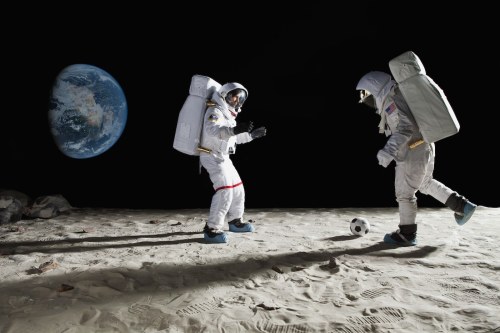*Exactly* how an aspiring astronaut is prepping her body to get ready for space
It's no joke that being an astronaut is a physically demanding job. Here's the astronaut workout routine that helps get them ready for space.

When team Well+Good found out that I was going to be interviewing aspiring astronaut Abigail Harrison—otherwise known as “Astronaut Abby”—they had a lot of questions, ranging from “What does an astronaut’s workout routine look like?” to, I kid you not, “Are aliens real?!”
While we’ll likely have to wait until the Area 51 raid (did you get your ticket yet?) to find out about that last one, Harrison did take the time to break down exactly what it takes for astronauts to get their bodies ready for space. The 22-year-old founder of The Mars Generation recently graduated from Wellesley College and is on a journey to become one of the first humans on Mars. But that journey—particularly from a physical standpoint—won’t be easy.
Going into outer space, it turns out, isn’t exactly great for your body, which means there’s a whole lot of physical prep and planning required for becoming an astronaut. “Not only do astronauts have to be the top of the line when it comes to their experience, research, and academics, but they also have to be really physically fit and capable,” says Harrison. “It’s a very highly-demanding physical job—both the job itself and training for it is physically demanding, but also, space exploration places a large wear and tear on the body.” She explains that the longer you’re in space, the more compounded the effects on your person—which include muscle and bone density loss, cardiac changes, and fluid shifts that can effect your vision and internal organs.
“They’ve found that one of the best ways to ensure that astronauts face minimal negative health effects from their time in space, and are able to recover after they return, is to make sure that they are in tip-top shape before they go to space, and that once they are in space, they spend a lot of time maintaining that physical level,” says Harrison.
There isn’t an astronaut “fitness test” the way there is for people applying to the Army or FBI. As Harrison puts it, “it’s much more of an individualized thing, because space is such a hostile environment to humans and every body reacts differently to the experience of microgravity.” There are, however, a few physical elements that astronauts need to focus on before they blast off. “It’s super important to have a good cardiovascular system built up because of those cardiac changes that happen because of the microgravity environment,” she says. “Muscle mass and bone density are also really important, so things like weight lifting can help to minimize those negative impacts of space exploration on things like cardiac fitness and bone and muscle density and integrity.”
These elements are tested on an individual level before a person is admitted into the space program, and again when they are assigned to a mission—which takes two years to train for. “Astronauts, during that time period, work with personal trainers and such to meet certain goals that are set to put them at the best baseline they can be at before they go into space,” explains Harrison.
Not surprisingly, these aren’t exactly things that can happen overnight. So, though Harrison estimates that her first trip to space won’t happen for at least 10 years, she’s already working on prepping her body for the journey. “I’m preparing not just for today or tomorrow, but for twenty years down the road when I might be in space,” she says. “Over the long term, I’m building these healthy lifestyles and focusing on areas like cardio and weight-bearing exercises that are important for space travel.” Harrison’s current workout routine involves a number of outdoor activities like rock climbing, hiking, bouldering, and rafting, and she is also currently training for a marathon.
Once astronauts actually make it into space—where they exercise between two and three hours a day to counteract the effects of microgravity on their body—their workouts become slightly more complicated because of the whole “no gravity” thing. “How do you work muscles without an opposition force to push them against? The answer is resistance training,” explains Harrison. “So, the majority, if not all of the exercise equipment on the international space station is very specialized and resistance based. There is a specific kind of treadmill that, in somewhat simplified terms, keeps you bungee corded down to it so that you can’t fly away and have something to push against while you run. There’s a stationary bicycle that they use that uses artificial resistance. Same with that, the weight training all has to be done through not actually adding weight, but adding resistance that you’re pulling or pushing against.”
While the rest of us probably don’t have what it takes to become astronauts—after spending 45 minutes on the phone with Harrison, I can say with full confidence that she is far more impressive than I (and most other humans) will ever be—they’re certainly worth turning to for fitness inspo… and at least some pretty legit motivation to get me to blast off from my couch to the gym.
Could you pass the Army’s new fitness test? Plus, the Navy SEAL secret for crushing your fitness goals.
Sign Up for Our Daily Newsletter
Get all the latest in wellness, trends, food, fitness, beauty, and more delivered right to your inbox.
Got it, you've been added to our email list.










